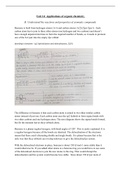Overig
Pearson BTEC Nationals Applied Science (2016)- UNIT 14B - Understand the reactions and properties of aromatic compounds
- Vak
- Instelling
AWARDED A DISTINCTION. UNIT 14B: Understand the reactions and properties of aromatic compounds Covers all the criteria needed for a Pass, Merit, and Distinction. Includes diagrams, (all *hand-drawn.) Everything is typed in a neat from, with clear headings. Everything is clearly referenced...
[Meer zien]




